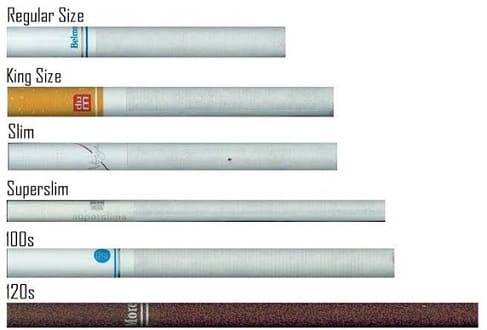![]()
Even though cigarettes mess with your health and life, they are everywhere for everyone. Wrap your head around this: One billion smokers bought 5.2 trillion cigarettes worldwide in 2020. To put that in perspective, the global population stood at 7.79 billion in 2020 and a trillion comes with a whopping nine zeroes. Guess what? Cigarette sizes help shape smoking behaviors and determine nicotine intake and overall health risks. Take an ex-smoker’s word for it, knowing the sizes and types of cigarettes can even help you quit. Sounds like an exaggeration? Not when you know the facts.
What is a Cigarette?
Think of a cigarette as a little stick of tobacco wrapped in thin paper. When you light one end of a cigarette and inhale, you’re breathing in the smoke of burning tobacco. It’s not the healthiest habit to have, given the health risks associated with smoking. Cigarettes come in all types to fit all needs, tastes, and budgets. Read More…
Cigarette Sizes 101:

- Image Courtesy: Quora
What do these numbers like 70mm, 84mm, 100mm, and 120mm mean? Let’s break it down.
1. 70mm:
Cigarettes originated as 70mm filterless sticks, all white with the paper wrapping going all the way to the tip. These cigarettes were all the rage before filtered cigarettes took over in the 1950s. Even though they’re not as commercially popular anymore, the roll-your-own crowd still prefers them. Since there’s no filter to catch tar and nicotine, 70mm cigarettes tend to be harsher on the lungs and throat. You can count on them for a more direct experience, a stronger kick, and affordability. Camel, Lucky Strike, and Paul Mall are the world’s leading cigarette brands in this segment.
Specifications:
| Length: 70mm | Diameter: 7.9mm | Tobacco: 0.8g |
| Smoking Time: 3-4 minutes | Puffs: 8-10 | Nicotine: 0.4-0.9mg |
2. Kings Size:
Call them the first cigarette size variants of regular cigarettes, measuring 84mm in length and 7.9mm in diameter. About 15mm longer than regular cigarettes, they were once the longest smokes in the market, hence, the name. These cigarette sizes became super popular once filters became a thing. They’re the standard size for most cigarette brands, be it Marlboro – the world’s most iconic brand, or Gold Flake Kings – India’s leading cigarette brand.
Specifications:
| Length: 84mm | Diameter: 7.9mm | Tobacco: 0.8g |
| Smoking Time: 4-5 minutes | Puffs: 8-12 | Nicotine: 0.5-1mg |
3. 100s (Longs):
100s is a self-explanatory term, meaning cigarettes measuring around 100mm in length. While their height exceeds that of regular cigarettes by 20mm, the diameter remains the same, 7.9mm. With a longer filter and more tobacco, they’re the upgrade from the King size. Benson & Hedges pioneered 100s, ridiculed for their unusual length in a late ’60s TV ad. Today, even alternative options like Herbal cigarettes and Organic cigarettes are embracing the 100mm size. Marlboro offers its three popular variants, Marlboro Gold, Marlboro Lights, and Marlboro Red in this size range.
Specifications:
| Length: 100mm | Diameter: 7.9mm | Tobacco: 1g |
| Smoking Time: 5-6 minutes | Puffs: 12-16 | Nicotine: 0.8-1.2mg |
4. 120s (Extra Longs):
Make way for the longest cigarette sizes out there. True to their name, these luxe sticks measure 120mm long and 7.2mm in diameter. They’re slim and sleek, marketed towards women and elite smokers. But don’t be fooled by their appearance — they’re just as harmful as any cigarette, despite their fancy packaging and striking looks. Top female cigarette brands like More and some leading luxury cigarette brands like Sobranie embrace this cigarette size.
Specifications:
| Length: 120mm | Diameter: 7.2mm | Tobacco: 1.2g |
| Smoking Time: 6-7 minutes | Puffs: 12-16 | Nicotine: 0.8-1.2mg |
5. Slims:
These cigarettes deserve a separate category, despite flaunting a 100mm size. The reason? Well, length isn’t the only size parameter. Slim cigarette, as the name says, is slimmer with a diameter of 7.2mm. Tobacco brands market them as a safer option to regular and king-size smokes. Top brands include Vogue, Esse, and Virginia Slims. Read More…
Specifications:
| Length: 100mm | Diameter: 7.4mm | Tobacco: 0.7g |
| Smoking Time: 5-6 minutes | Puffs: 9-10 | Nicotine: 0.4-0.7mg |
6. Super Slims:
How about the skinniest cigarette? Super slims are a refined version of slim cigarettes, typically measuring 120mm in length and 5.0-6.5mm in diameter, depending on the brand. Popular among elite female smokers, super slims usually feature less nicotine and tar. Top super slim cigarette brands include More, Esse, Mond, and Davidoff. Read More…
Specifications:
| Length: 110-120mm | Diameter: 7.2mm | Tobacco: 0.5g |
| Smoking Time: 6-7 minutes | Puffs: 10-12 | Nicotine: 0.3-0.6mg |
7. Mini:
Looking for a quick smoke? A mini cigarette would serve your purpose well. As the name suggests, they are smaller and skinnier than any other smoke, measuring 57-70mm long and 5.0-6.5mm in diameter. Plus, they are cheap.
Specifications:
| Length: 57-70mm | Diameter: 5.0-6.5mm | Tobacco: 0.3-0.5g |
| Smoking Time: 2-3 minutes | Puffs: 6-8 | Nicotine: 0.2-0.4mg |
8. Wide:
Wide cigarettes might not be that popular, but they are a cigarette size category nonetheless. Wides are wide, about 8-8.5mm in diameter. However, they mimic regulars in size, about 84mm. Camel introduced this category and continues to rule the roost with some widely popular options, such as Camel Menthol Wide, Camel Blue Wide, and more.
Specifications:
| Length: 80mm | Diameter: 8-8.5mm | Tobacco: 0.8-1g |
| Smoking Time: 4-5 minutes | Puffs: 8-10 | Nicotine: 0.5-1mg |
9. Shorties:
Ever heard of “shorties”? They’re like fast food – quick, convenient, and easy on the wallet. A typical shorty measures around 70mm in length with a narrower 7mm diameter and around 0.5 grams of tobacco. Their dimension makes them perfect for a quick smoke session lasting just 2-3 minutes. You’ll often find the cheapest cigarette brands available in this “shorty” size. On the downside, their quality isn’t great and they aren’t as easily accessible everywhere.
Specifications:
| Length: 70mm | Diameter: 7mm | Tobacco: 0.5g |
| Smoking Time: 2-3 minutes | Puffs: 6-8 | Nicotine: 0.5-0.7mg |
Disclaimer: Cigarette sizes, tobacco, and nicotine levels vary by brand. Similarly, the number of puffs and smoking time are individual-specific, based on my personal experience.
Cigarette Sizes Chart
The Cigarette Sizes chart depicts the length and diameter of each size variant out there.
| Cigarette Type | Length | Diameter |
| King Size | 84mm | 7.9mm |
| 100s | 99-101mm | 7.9mm |
| 120s | 119-121mm | 7.9mm |
| Regular | 68-74mm | 7.9mm |
| Slim | 84-100mm | 7.2mm |
| Super Slim | 100-120mm | 5.0-6.5mm |
| Mini | 57-70mm | 5.0-6.5mm |
| Wide | 84mm | 8.1-8.5mm |
| Shorties | 60-70mm | 5.0-7.0mm |
Why Cigarette Size Matter? Research Insights
The impact of cigarette size on smoking behavior is a well-documented fact. Here are a few research-based insights.
1. National Cancer Institute: Human Smoking Behavior
Smoking habits change over time. To tackle the smoking epidemic, we need to grasp how different smoking behaviors affect how much smoke a person inhales. (The inhalation depends on the cigarette’s size.)
2. Can cigarette size influence smoking and puffing rates?
In a study, participants adjusted their smoking habits based on the lengths of cigarettes (full, half, quarter, and eighth), with satisfaction levels directly linked to cigarette length.
3. Smoking-related psychosocial beliefs and justifications
Functional beliefs like “smoking helps with stress” often overpower beliefs about reducing health risks. Those who successfully quit smoking tend to lessen their reliance on these functional beliefs rather than focusing on minimizing risks. (Switching to smaller or lighter cigarettes might address these functional beliefs.)
Knowing Cigarette Sizes: An Ex-Smoker’s Guide to Quitting
Let an ex-smoker emphasize the importance of understanding cigarette sizes in quitting the habit.

-
Awareness of Consumption:
When you know the size, you are mindful of how much you’re smoking. It’s like having a visual cue that prompts you to keep track of your intake. As it turned out for me, mindfulness was the first step towards smoke-free life.
-
Setting Goals:
Once you start quantifying your nicotine intake, it’s simpler to set achievable goals for cutting down on smoking. Whether it’s reducing daily cigarette intake or switching to smaller sizes, quitting now seems more attainable.
-
Switching Strategies:
Experimenting with various sizes can help transition to lower-nicotine options or alternative smoking methods. While smoking in all forms is bad, alternative smoke can serve as a nonsmoking aid. Some even try sweet cigarettes to this end.
-
Budgeting:
Larger cigarette sizes come with a higher price tag. Understanding the sizes can help you make informed decisions about your spending and prioritize your health over unnecessary expenses. It’s a motivating factor for many to quit.
-
Motivation:
Lastly, understanding the health implications of cigarette sizes can strongly motivate you to quit. Even small changes can significantly impact your well-being, inspiring a move towards a smoke-free life.
Cigarette Pack Sizes:

A cigarette pack is often a rectangular paperboard box that features flavor-protective foil, sealed tight with a transparent, airtight plastic film. However, certain brands might ditch the expensive foil for paper or plastic to restrict prices. The design is brand-specific. Take, for example, ITC Cigarette brands that use a more ergonomic hinged-lid design. About 80% of packet’s real estate features a mandatory warning regarding tobacco’s health impact.
Cigarette Pack Sizes: Evolution
In the 19th century, cigarette pack sizes were all over the place, from loose rolls to tiny paper packs. It wasn’t until 1920 that we got a tidy standard pack of 20. During World War 2, they bulked up, fitting snugly into tin containers with 50 to 56 sticks per pack. Come the ’60s, brands stuffed in 25 to 30 cigarettes to entice buyers and boost profits.
But as health concerns grew, so did regulations. In 1985, the USA made 20 cigarettes per pack the law. By the 2000s, some brands went even smaller, offering packs with fewer than 20 cigarettes, all in the pretext to snuff out puffing.
Country-wise Cigarette Pack Sizes:
How many sticks a cigarette packet contains also shapes smoking choices. The more sticks a packet contains, the higher the price it fetches, pure and simple. Again, the cigarette box sizes are country-specific and vary accordingly. That’s mainly because the government regulations are different in different countries. Here’s your lowdown.
| Country | Pack Sizes | Regulations |
| Australia | 20, 25, 26, 30, 40, 50 | The government sets minimum pack size |
| Canada | 20, 25 | |
| Europe | Variable | Cigarette tax changes affect pack quantity |
| Malaysia | ≥ 20 | Prohibited sale of packs with fewer than 20 cigarettes |
| United States | ≥ 20 | Minimum pack size of 20; some brands offer packs of 25 |
| Ireland | 33 | |
| India | ||
| United Kingdom | 20 | New laws restrict loose tobacco sales to multiples of 30g/50g; outlaw the sale of 10-stick packs and branded packaging, introducing plain green boxes |
| China |
Factors Determining Cigarette Pack Sizes:
According to a study by UK Tobacco Control, cutting down the number of cigarettes in a pack from 20 to 10 can lead to a 10% drop in tobacco intake. My personal experience tells me that larger packs tempt smokers to puff away more, upping their health risks. That said, three prominent factors shape cigarette pack sizes worldwide.
1. Changes in the Market:
Given the intense competition, cigarette brands are left to introduce low-cost packs with higher cigarette counts. The idea is to gain customer loyalty and create a strong brand identity.
2. Health Concerns and Regulations:
The rising health awareness is prompting stricter tobacco regulations. Brands are now required to slap warning labels and ditch fancy packaging in places like India, the US, the UK, and Australia. No more flashy logos, just stark warnings.
3. What Smokers Want:
Now, smokers are getting savvier about their health. They’re opting for smaller packs with fewer cigs (think 10-12). The cigarette brands have no choice but to cater to their changing preferences.
Cigarette Sizes: Takeaways
The popularity of a given cigarette size may vary from country to country. While regular-sized filter cigarette options hold sway in India and other developing countries, King Size and 100s find more takers in the US and Europe. You’ve got some outliers like 120s, 72s, Slims, and more, but those cater to specific tastes. The diameter is pretty standard at 7.9mm for most, except for Slims and Super Slims. Also, tobacco brands might tweak the length and diameter a bit to suit their target customers. Low on nicotine and high on style, super slims are perhaps the most expensive option.
Conversely, for those seeking an alternative, gutka and pan masala, offer a distinct option. As smoking trends evolve, individuals increasingly explore options like top pan masala brands and top gutka brands for a different sensory experience. However, these smokeless chewing tobacco options are equally addictive and risky.
FAQs:
1. What are the sizes of smokes?
Cigarette comes in various sizes, including regular (70mm), king size (84mm), 100s (100mm), 120s (120mm), Slims (100mm), Super slims (110-120mm), Minis (57mm), Wides (70mm), and Shorties (70mm).
2. What is the most popular cigarette size?
The popularity of cigarette sizes is country-specific. In the US, Europe, Australia, and Canada, king size is the standard. However, in the developing world, regular-size cigarettes are more in demand.
3. What size packs do cigarettes come in?
It depends on the brand, country, and other factors. Typically, the authorities determine the pack size in their countries. For more info, refer to the Cigarette Sizes Chart provided above.
4. How many cigarettes come in a carton?
A carton features 10 packs, each with 20 cigarettes. That amounts to 200 cigarettes per carton.
Suggested Reading:
- All Cigarette Name List: Full Spectrum
- Best-Selling Menthol Cigarette Brands
- Best Lighter Brands: A Definitive Guide
- World’s Top Disposable Vape Brands in 2024
- The Best Clove Cigarette Brands: Ultimate Guide
- Clove Cigarette Unleashed: From Indonesia to the World
- What Are the Best 10 Cigarette Brands in Pakistan?
- Sheer Extravagance: Most Expensive Cigarette in India Revealed
Feature Image Courtesy: Freepik
A wordsmith, avid traveler, rationalist, brand loyalist, sports-freak, and an independent researcher, Rohit has authored 18000 writeups for some of the leading online and offline publications in the past 10 years. He digs into information, weaves narratives, and distills complex subjects into engaging content.
